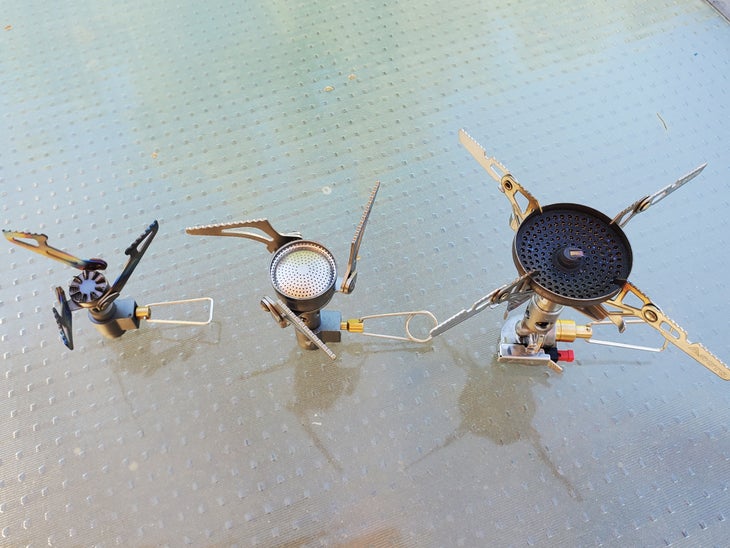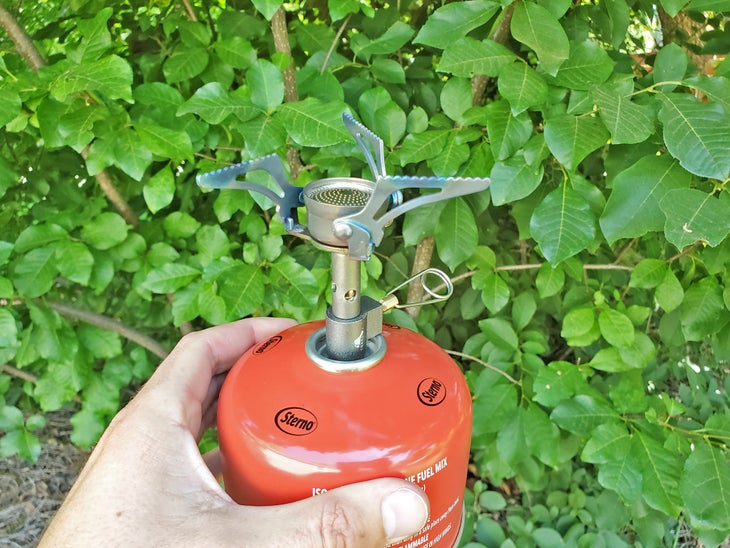Heading out the door? Read this article on the new Outside+ app available now on iOS devices for members! Download the app.
Toaks is known for its affordable titanium cookware, like pots, spoons, and wood-burning stoves. Now, the brand is releasing a gas canister stove, designed to combine the ultralight sensibilities of the lightest burners with the fuel-savings of larger models. To put it to the test, we compared it against two of our favorite canister stoves, the Soto Windmaster—which got top billing among backpacking stoves in this year’s Gear Guide—and the BRS 3000T—the lightest on the market.
First Impressions
In general, the Toaks stove has far more in common with the BRS than the Windmaster. In terms of price, the $30 Toaks is in the same super-cheap tier as the BRS, even if it is a good $13 more expensive. The Windmaster, meanwhile will run you $70. Then, there’s the weight. At 1.7 ounces, the Toaks hews closer to the 0.9 ounces of the BRS rather than the 3 ounces Windmaster. The similarities between the Toaks and the BRS carry through in their designs, as well. The Toaks is essentially a slightly larger, beefier BRS, albeit with a different burner head (more on that later). Both are made of titanium and have three folding pot stands. They both lack an ignitor or regulator—though in our view, neither of these are deal-breakers on such lightweight stoves.
The biggest difference between the BRS and Toaks comes in the quality of construction, particularly in the thickness of the titanium components. The Toaks is impressively robust for such a small, lightweight stove. The pot stands are noticeably thicker than on either the BRS or Windmaster, and less prone to bending or breaking. Throughout the stove, the construction is slightly burlier than the average canister stove. It’s clear that Toaks could have shaved a bit more weight from the design, but opted for added heft and durability instead.

Performance
In calm conditions, the Toaks is a fine performer. An average boil of 16 ounces of water over a medium flame took about three to four minutes, and burned between 7-9 grams of fuel. This is pretty standard for lightweight stoves—we’ve found that most stoves have similar numbers in perfect conditions.
In use, the Toaks stove operates more like the BRS than the Windmaster. Though the burner head is about twice the size of the BRS, it still emits a focused flame along with a fairly loud roar. In comparison, the Windmaster’s burner is again about twice the size, and operates nearly silently.
One quirk of the Toaks is that the control valve that regulates the flow of fuel is quite touchy. Gas starts to flow as soon as you crack the valve open at all. In comparison, both the BRS and the Windmaster have some “dead space” where the control lever turns before the valve is actually open. This isn’t a huge gripe, but it does make using the stove on a low setting a bit trickier because the range of adjustment is narrower.
Performance in Wind
By far the most intriguing feature of the Toaks gas stove is the cupped burner head. In our testing, this simple raised edge around the burner is one of the biggest performance upgrades in the wind outside of heavy add-ons like wind screens or proprietary pots. Our main gripe with the BRS stove is its exposed burner head and poor performance in even light winds.
To test the Toaks, we conducted more boil tests with all three canister stoves in front of a small fan that simulated a constant-but-mild 7 mile-per-hour wind. We used the same 750 millimeter pot and 16 ounces of water for each stove.
As expected, the Windmaster performed well. With a medium flame, the water boiled in about 6 minutes using 11 grams of fuel. With a lower flame, it boiled water in about 10 minutes using 9 grams of fuel. The results from the Toaks? Over a low flame, it boiled water in 11 minutes using 11 grams of fuel. But with the flame cranked higher to achieve a 6 minute boil, it burned through a full 31 grams of fuel. (The BRS stove burned through even more fuel and still failed to achieve a full boil).
What do all of those numbers mean? Basically, the Windmaster is “set and forget” stove in moderate winds. Whatever flame height you want, it’s pretty efficient at saving as much fuel as possible. The Toaks, meanwhile, is efficient with a low flame, but gets more and more wasteful as you open the valve. An inexperienced or inattentive user could easily blow through a canister of gas in windy conditions without realizing it. But if you turn the flame down and accept slightly longer boil times, it’s a decent performer.
So, why is the Windmaster still the superior stove when things get gusty? In our view, it comes down to three factors. First of all, the raised edge around the burner is slightly taller than on the Toaks, which provides a bit more protection. Secondly, the burner head is larger, which is simply more efficient in all conditions. Lastly, the Windmaster’s removable pot stands attach directly to the burner head, which leaves a very small gap between the burner head and the pot: about a quarter-inch. The folding pot stands on the Toaks create a pot-to-burner gap of about five-eights of an inch. Put simply, this extra space between pot and burner is more real estate for wind to push the flame around and create inefficiencies in heat transfer.

Who is the Toaks Stove For?
In all, the Toaks is the cheapest and lightest stove we’ve tested that offers at least decent performance in windy conditions. On that basis alone, its a good buy. For a weight penalty of 0.8 ounces, the Toaks removes the biggest downside of the BRS stove—the exposed burner head—and adds a larger burner and sturdier construction to boot. While there are sure to be some committed ultralighters who stick with the BRS purely for the weight savings, most backpackers would be better served by the Toaks in a broader range of conditions for a nominal weight and cost penalty.
On the other hand, anyone who’s used a stove like the Soto Windmaster or MSR PocketRocket Deluxe will likely be underwhelmed by the performance of the Toaks. There’s a good reason the WIndmaster gets the nod as our top pick among all backpacking stoves. For another ounce and change, it offers a lot—better simmer control and performance in the wind, quieter operation, and more fuel savings. When you consider that you can drop the weight to 2.3 oz by swapping to the TriFlex pot support, the Windmaster remains our top pick, even for ultralighters.
From 2025
